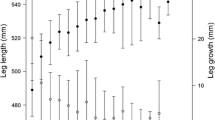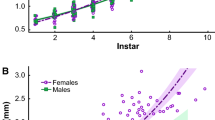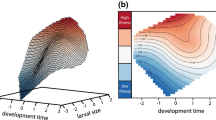Summary
A model predicting optimal age and size at maturity is presented, exploring the conflict between growth and energy allocation to reproduction. According to the model, the factors promoting delayed maturity and large adult body size are as follows: (1) high rate of somatic growth, (2) high percentage increase in reproductive rate with body size increase, (3) long life expectancy at maturity for annuals or large number of expected productive days (when either growth or reproduction is possible) for perennials with growth ceasing at maturity, (4) life expectancy increasing with body size. All these factors are combined in the mathematical formula predicting optimal age and size at maturity, which allows for quantitative predictions. The optimal schedule of growth and reproduction may be achieved by natural selection, developmental plasticity, or when one species replaces another. Sexual size dimorphism is also discussed, resulting from different optimal age at maturity for either sex.
Similar content being viewed by others
References
Alberch, P., Gould, S. J., Oster, G. F. and Wake, D. B. (1979) Size and shape in ontogeny and phylogeny.Paleobiology 5, 296–313.
Andrews, R. M. (1982) Patterns of growth in reptiles. InBiology of the Reptilia (C. Gans, ed.) pp. 273–320. Academic Press.
Bertram, B. C. R. (1975) Social factors influencing reproduction in wild lions.J. Zool. (Lond.)177, 463–82.
Clutton-Brock, T. H., Guiness, F. E. and Albon, S. D. (1982) Red deer.Behavior and Ecology of Two Sexes. Edinburgh University Press, UK.
Cohen, D. (1971) Maximizing final yield when growth is limited by time or by limiting resources.J. Theor. Biol. 33, 299–307.
Crandall, R. E. and Stearns, S. C. (1982) Variational models of life-histories: when do solutions exist?Theor. Pop. Biol. 21, 11–23.
Eisenberg, J. F. (1981)The Mammalian Radiations. Univ. Chicago Press, Chicago, USA.
Gilbert, J. J. and Williamson, C. E. (1983) Sexual dimorphism in zooplankton (Copepoda, Cladocera, and Rotifera).Ann. Rev. Ecol. Syst. 14, 1–33.
Gould, S. J. (1977)Ontogeny and Phylogeny. Harvard University Press, Cambridge, MA, USA.
Harvey, P. H. and Zammuto, R. M. (1985) Patterns of mortality and age at first reproduction in natural populations of mammals.Nature 315, 319–20.
Hayssen, V. and Lacy, R. C. (1985) Basal metabolic rates in mammals: taxonomic differences in the allometry of BMR and body mass.Comp. Biochem. Physiol. 81A, 741–54.
Holmsgard, E. and Olsen, H. C. (1966) Experimental induction of flowering in beech.Forstl. Forsogsv. Danm. 30, 1–17.
Howard, R. D. (1981) Sexual dimorphism in bullfrogs.Ecology 62, 303–10.
Howard, R. D. (1983) Sexual selection and variation in reproductive success in a long-lived organism.Amer. Natur. 122, 301–25.
King, D. and Roughgarden, J. (1982a) Multiple switches between vegetative and reproductive growth in annual plants.Theor. Pop. Biol. 21, 194–204.
King, D. and Roughgarden, J. (1982b) Graded allocation between vegetative and reproductive growth for annual plants in growing seasons of random length.Theor. Pop. Biol. 22, 1–16.
Kozlowski, J. (1985) Optimization of age at maturity and its morphological consequences in mammals.Zesz. nauk. Filli UW 48, 1–9.
Kozlowski, J. and Uchmanski, J. (1987) Optimal individual growth and reproduction in perennial species with indeterminate growth.Evol. Ecol.,1, 214–30.
Kozlowski, J. and Wiegert, R. G. (1986) Optimal allocation of energy to growth and reproduction.Theor. Pop. Biol. 29, 16–37.
Kozlowski, J. and Ziolko, M. Optimal allocation of energy to growth and reproduction when the maximum rate of reproductive growth is limited (submitted toTheor. Pop. Biol.).
Lavigne, D. M. (1982) Similarity in energy budgets of animal populations.J. Anim. Ecol. 51, 195–206.
Lederhouse, R. C., Finke, M. D. and Scriber, J. M. (1982) The contributions of larval growth and pupal duration to protandry in the black swallowtail butterfly,Papilio polyxenes.Oecologia (Berl.)53, 296–300.
Millar, J. S. and Zammuto, R. M. (1983) Life histories of mammals: an analysis of life tables.Ecology 64, 631–5.
Minchella, D. J. and Loverde, P. T. (1981) A cost of increased early reproductive effort in the snailBiomphalaria globrata.Amer. Natur. 118, 871–81.
Mirmirani, M. and Oster, G. (1978) Competition, kin selection, and evolutionary stable strategy.Theor. Pop. Biol. 13, 304–39.
Mueller, H. C. and Meyer, K. (1985) The evolution of reversed sexual dimorphism in size: a comparative analysis of the Falconiformes of the Western Palearctic. InCurrent Ornithology Vol. 2 (R. F. Johnston, ed.) pp. 65–101.
Newton, I. (1979)Population Ecology of Raptors. Buteo Books, Vermillon, South Dakota, USA.
Schaffer, W. M., Inouye, R. S. and Whittam, T. S. (1982) Energy allocation by an annual plant when the effects of seasonality on growth and reproduction are decoupled.Amer. Natur. 120, 787–815.
Singer, M. C. (1982) Sexual selection for small size in male butterflies.Amer. Natur. 119, 440–3.
Stearns, S. C. and Crandall, R. E. (1981) Quantitative predictions of delayed maturity.Evolution 35, 455–63.
Sutherland, W. J., Grafen, A. and Harvey, P. H. (1986) Life history correlations and demography.Nature 320, 88.
Vincent, T. L. and Puliam, H. R. (1980) Evolution of life history strategies for an asexual annual plant model.Theor. Pop. Biol. 17, 215–31.
Wiley, R. H. (1974) Evolution of social organization and life-history patterns among grouse.Q. Rev. Biol. 49, 201–27.
Woolbright, L. L. (1983) Sexual selection and size dimorphism in anuran Amphibia.Amer. Natur. 121, 110–19.
Ziolko, M. and Kozlowski, J. (1983) Evolution of body size: an optimization model.Math. Biosci. 64, 127–43.
Author information
Authors and Affiliations
Rights and permissions
About this article
Cite this article
Kozłowski, J., Wiegert, R.G. Optimal age and size at maturity in annuals and perennials with determinate growth. Evol Ecol 1, 231–244 (1987). https://doi.org/10.1007/BF02067553
Issue Date:
DOI: https://doi.org/10.1007/BF02067553




